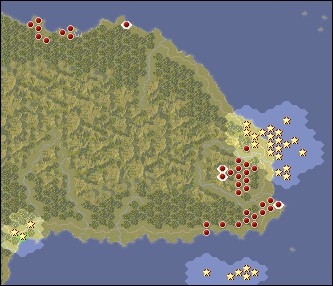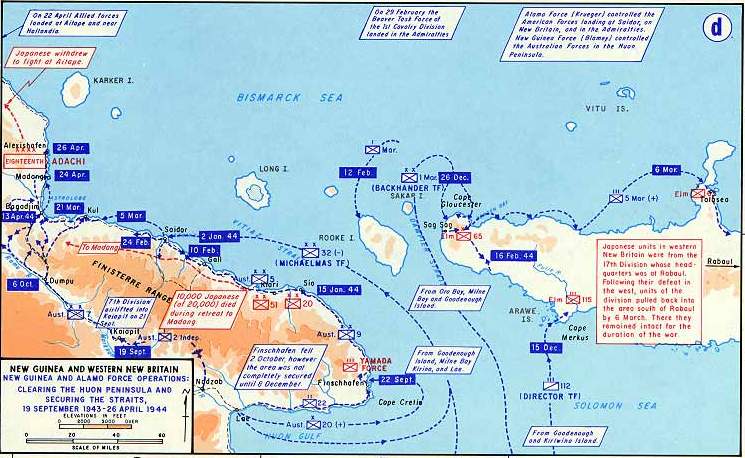 When you move the mouse pointer over the map, unit name, strength and coordinates are displayed as a label. When you press terrain button object name is displayed (city, river, sea, ...) |
Finschhafen
19.9.1943 - 15.1.1944
PacPG: 22.9.1943 - 20.1.1944
Scenario Map:
|
|
|
Changes and corrections of map:
|
Scenario author: Scenario origin: Last revision date: |
stanny 15.6.2005 30.7.2009 |
First release: Revision released: |
4.8.2009 ( Release 01 ) - |
| Completely new scenario. Continuation of the Allied advance along the New Guinea coast. |
Historic overview:
| While the South Pacific Forces of Admiral Halsey waged tough battle on New Georgia, General MacArthur in the southwest Pacific was preparing an offensive in New Guinea to occupy the Japanese base in Salamaua, Lae, Finschhafen and Madang, and thereby gain control over the straits of Vitiaz and Dampier, separating New Guinea from New Britain. Their mastery opened to the Allies the way to the Bismarck Archipelago and go to the Philippines. (Miloš Hubáček - Ofenzíva v Pacifiku, Mladá fronta 2000) It was originally planned to attack on Finschhafen 6 weeks after the occupation of Lae. But since occupation of Lae and Salamaua had been done very quickly, and also allied staff received information about movement of the Japanese 20th Division to Finschhafen, it was decided to shorten the term of attack and begin on September 22, 1943. Article on English Wikipedia
| |||||||||||||||||||||||||||||||||||||||||||||||||||||||||
Game play matters:
| Campaign play: Defeat means end of the campaign. After Minor victory follows scenario Borneo 45, after Major victory Buin. |
Scenario data:
|
Map size: 42 x 35 hexes 13 turns, 10 days per turn Version: PacAGPG 2, Starting side: Allies, Campaign: Australian campaign, Order in campaign: 2. |
||||||||
|
||||||||
|
||||||||
|
||||||||
|
||||||||
|
Game time costingness of scenario: 9.78 % (product of units and turns numbers divided by difference between the most long and the most short scenario) |
||||||||
|
Number of Allied units: 36 units, from them are 10 core units and 26 auxiliary units 7 air units, 4 naval units and 25 ground units 0 of units are loaded to air transport and 17 to naval transport |
Transports Air/Naval: Allies - Axis 0/17 - 0/0 |
|||||||
|
Number of Axis units: 41 units 5 air units, 0 naval units and 36 ground units 0 of units are loaded to air transport and 0 to naval transport |
Initial prestige + every turn donation: Allies / Axis 300 + 0 / 382 + 41 |
|||||||
|
Max number of Allied units: 38 units, from them are 10 core units and 28 auxiliary units - on start of scenario is possible to purchase 2 unit (0 core + 2 auxiliary) |
||||||||
|
Max number of Axis units: 41 units - on start of scenario is possible to purchase 0 unit |
||||||||
Transport units:
|
||||||||
|
| Allied units: P-47D Thunderbolt (USA) P-39 Airacobra (USA) Douglas A-20 Havoc (USA) B-26C Marauder (USA) Destroyer (USA) ANZAC 1943 (Australia & New Zealand) Bridge Engineers (Australia & New Zealand) HW Infantry 36 (Australia & New Zealand) Matilda II (Australia & New Zealand) 6 Pdr ATG (Australia & New Zealand) 25 Pdr Gun (Australia & New Zealand) 15 Pdr Gun (Australia & New Zealand) 20mm AD (Australia & New Zealand) CA-13 Boomerang (Australia & New Zealand) CA-8 Wirraway (Australia & New Zealand) P-40 Kittyhawk (Australia & New Zealand) GB 3 Ton Lorry (Australia & New Zealand) AF Transport (Australia & New Zealand) |
Axis units: Kyoka Hohei 1943 (Infantry HW 1943) (Japan) Hohei 1943 (Infantry 1943) (Japan) Kyoka Hohei 1940 (Infantry HW 1940) (Japan) Hohei 1940 (Infantry 1940) (Japan) Type 94 37mm (Japan) Type 94 75mm (Japan) Meiji 38 Improved 75mm Field Gun (Japan) Type 98 20mm (Japan) Type 88 75mm (Japan) Strong Point (Japan) Ki-43 Oscar (Hayabusa) (Japan) Ki-51 Sonia (Guntei) (Japan) Ki-48 Lily (Japan) Isuzu Type 94 6-Wheeled Truck (Japan) |
The same time period scenarios:
| Bougainville (PacAGPG 1), Tarawa (PacAGPG 1), Makin (PacAGPG 1), Finschhafen (PacAGPG 2), Tarawa (PacPG 1), Makin (PacPG 2) |
| Arndt Point Bismarck Sea Blucher Point Buhem River Buso River Busu River Dallman River Finschhafen Finschhafen Airfield Go River Display all mapnames in list... |
Tactical map (large & detail):

|
|
|
|
Basic map |
|
|
Map with unloaded transports and order numbers of units |
Battlefield map:

|
|